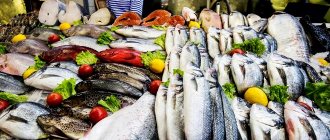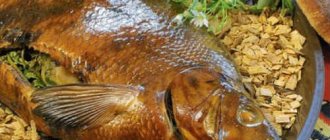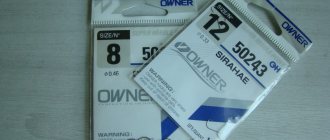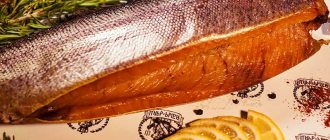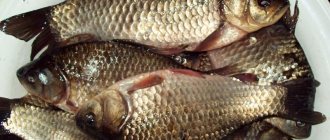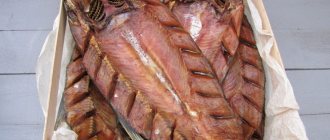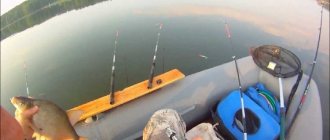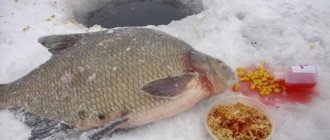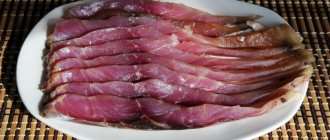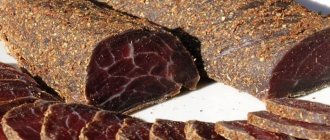What kind of fish goes for balyk
Any large fish whose meat has high and medium fat content is considered suitable for preparing balyk.
Fatty fish with a small number of small fork bones is prized, but balyk can be made from almost any fish of sufficiently large size. The most popular types of fish from which delicious balyk is made are asp, silver carp, catfish and carp. Balyk made from sturgeon and red fish from the salmon family will be very tasty. The fattest fish will be any fish caught in the autumn and early winter.
List of fish that make delicious balyk, grouped by popularity:
- Asp, ide, chub, bream;
- Silver carp;
- Catfish;
- Carp, carp, crucian carp;
- Mackerel, mackerel, tuna;
- Pike, zander;
- Chum salmon, pink salmon, trout, omul, whitefish, nelma, salmon;
- Sturgeon and sturgeon species of fish.
There is a fish on this list that cannot be considered a boneless fish and is not a fatty fish, but this does not mean that it cannot be used to make balyk. There will always be lovers of dietary lean meat, for example, pike or pike perch in the form of balyk.
The asp is at the top of this list not because it makes the most delicious balyk, but because it more often ends up in the hands of the fisherman as a trophy. This is a rather bony fish, and when the question arises of how to cook it, two options come to mind: mince it and fry the cutlets, or make balyk and then deal with the bones - it is much more convenient to do this in dried fish than in cooked in a different way.
The fish from which balyk is prepared can be divided by size into medium, large and very large. Medium-sized fish is used for balyk almost entirely, and large ones undergo preliminary cutting - it is divided into tesha and the balyk itself. Very large fish is cut into pieces.
Cooking balyk
There are a huge variety of ways to prepare balyk, and there is always the possibility of improvisation, but there are also common principles that you should try to follow.
Fish balyk is divided by type of fish, size, salting method, type and degree of drying of fish meat. Cold smoked balyk (drying fish in cooled smoke) turns out to be very tasty, but it cannot be prepared at home.
- Large fish are flattened on the side and cut for uniform salting and drying;
- A not very large fish is flattened along the ridge without ripping open the belly, the head and tail are not removed, only the gills and entrails are removed;
- Very large fish are filleted, which is cut into pieces from which the balyk is prepared separately from the meat;
- To speed up the process of preparing balyk, the skin of the fish is removed;
- If the fish is fished in pieces, their size should be large, but in moderation - small pieces dry out quickly, and too large pieces are poorly salted;
- The taste of balyk depends not only on the salting method, but also on the degree of drying - the drier the fish meat, the saltier it is;
- The salt that is used for salting fish should be coarse without foreign impurities;
- After salting, the fish should be soaked for as many hours as the number of days it was in the brine;
- To obtain the spicy taste of balyk, at the stage of salting the fish, up to ½ part of sugar (usually 20-30%) and spicy spices (allspice, nutmeg, bay leaf, black peppercorns, coriander, cloves, ginger and others) are added to the salt. .
In general, preparing fish balyk is done as follows:
- The fish is scaled and cut;
- Prepared fish is salted dry or in brine;
- Salted fish undergoes soaking, which removes excess salt;
- The fish is hung out for drying or sent for cold smoking.
It should be noted that balyk salted in brine, in cool conditions, can remain in it for several months.
Fish balyk
In the minds of most people, fish balyk is considered an expensive dish, which is often served on an important occasion.
In fact, you can cook and serve balyk as part of an ordinary everyday meal, and it is not necessary to use only red varieties of fish as raw materials; you can use perch, silver carp or bream.
Recipes made from this material will serve especially well for avid fishermen and their families, since the best balyk always comes from a fresh catch.
How to make balyk from fish at home?
The recipe for a simple balyk, in addition to the fish itself, includes salt and sugar. There are no specific instructions regarding gramming; just remember a simple proportion: 10 tablespoons of salt and 3 tablespoons of sugar for every kilo of fish. Based on this proportion, you can cook any fatty fish, following the technology described below.
We start with cutting the fish. It must be done very carefully and carefully, clearing the abdominal cavity not only of the insides, but also of films and blood clots. Rinse the cleaned belly and dry the carcass.
Features and benefits
Bream is a freshwater fish of the carp family that lives throughout the Eurasian territory. It is consumed fried, boiled (for fish soup), dried and dried. The energy value per 100 g of product is 220 kcal. The main part is protein - 42 g, the mass fraction of fat is 5.9 g. There are no carbohydrates. Bream meat is rich in vitamins E, PP, and group B.
The high content of mineral compounds of phosphorus, fluorine, calcium, magnesium, sulfur and chlorine has a beneficial effect on human health, helping to accelerate metabolic processes. Fatty acids contained in fish strengthen the walls of blood vessels, prevent strokes, and normalize cardiovascular activity. Being a natural antioxidant, bream meat has a positive effect on the skin and delivers beneficial enzymes to the mucous membranes of internal organs.
Along with the beneficial properties of fish, you need to take into account some of its features. Without knowing them, you can harm the body.
- So, first of all, dried or dried bream requires a large amount of salt. Therefore, it is not recommended to abuse the product not only for those suffering from edema, but also for healthy people.
- People with individual intolerance to fish products and allergic reactions also fall into the risk zone.
- Bream contains many small, thin bones that can get stuck in the throat. Therefore, you should chew it carefully, thoroughly cleaning the meat before doing so.
- Improperly cooked fish carcass can cause intestinal infections. The best option for preventing such cases is to independently select fresh fish and salt it at home.
Dried bream
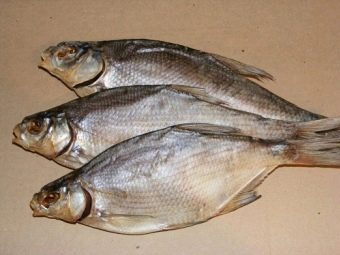
Dried bream
Pickled asp – finger-licking recipe
Ingredients: The recipe requires very little:
- Coarse salt at the rate of 250 - 300 grams per 1 kg of fish meat.
- Spices to taste (if desired):
- 1 pinch of dry dill;
- ¼ teaspoon ground black pepper;
- 2 medium cloves of finely chopped garlic.
We suggest you read: How to catch trout in winter, selecting bait for trout in winter || How to properly make and install a trout trap in winter
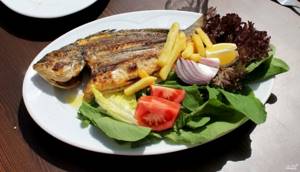
It is very important to control the progress of the process throughout in order to prevent flies, midges and other insects from getting on the fish: the entire prepared asp may spoil.
Preparation. The recipe further describes the step-by-step procedure:
- Prepare about 1 kg of coarse table salt. One or two pieces of cotton fabric of the required size. Heavy object as oppression. Washing the fish.
- Using a sharpened steel knife, cut the fish carcass from the back from head to tail. We cut along with the rib bones, cutting right down to the abdomen so as not to lose fat. This results in a so-called “layer”. (Be careful not to damage the gallbladder, otherwise the meat will taste bitter).
- We clean the entrails and remove the gills. Wash off all residues and blood.
- Use a separate cloth to soak up the moisture from the entire surface.
- We fill the entire “layer” with a thickness of approximately 1 mm with salt and spices. Place under pressure for at least 12 – 14 hours (salting time depends on the size, thickness and weight of the fish).
- At the end of the salting process, the carcass must be soaked in water. (If the fish weighs 2 kg, the soaking time will be about 3 hours. Fish weighing about 3 kg should be soaked for less time - already an hour and a half. It is advisable to do everything under running water. If this is not possible, the volume of liquid should be no less than 5 liters. Water must be changed 4 - 5 times.
- We wrap the almost finished balyk with a prepared piece of cotton cloth soaked in a 9% vinegar solution. The recipe for asp balyk recommends hanging the fish preserved in this way out into the air in the shade, or in a draft indoors for 3 or 4 hours. The edges of the material must be connected without tears or cracks!
- Then put it in the refrigerator for a day.
- The final touch is to place the fish in the sun for 1 hour until it is covered with droplets of fat.
Ingredients. Here is the “wet” method:
- Coarse table salt at the rate of 0.8 kg per 2.5 liters of water.
- 10 kg of fish (it is advisable to select carcasses of the same size and weight).
- 2 – 2.5 m of gauze or other light fabric.
- Spices:
- 3 bay leaves;
- 6 – 8 black peppercorns;
- ¼ spoon of dry dill;
- ¼ teaspoon fennel seeds;
- 1 - 2 medium cloves of garlic.
Preparation. The salting procedure is simple, but relatively long-term:
- Prepare brine or brine for salting fish: boil water, simultaneously dissolving salt in it. Just before boiling, pour the prepared spices into the pan to give the desired taste.
- After boiling, set aside and let cool.
- We cut the fish in the usual way: we clean the insides and gills, but we add another touch: we cut along the entire length of the back from head to tail.
- Place the cleaned and washed fish in a bowl and add a little salt.
- Fill with ready-made brine (temperature of the finished brine is 30 - 40 degrees). It should cover all the carcasses by 2 - 3 mm.
- And then we remove the container for 48 hours in a cool, dark place.
- After this time, hang the salted fish in a row on a nylon thread (for asps, it is better to thread the thread through the eyes). We protect with gauze cloth from the attacks of flies and other insects.
The drying place should be shady, dry and well ventilated. After a couple of weeks, you can begin to remove the first specimens, which are smaller, and monitor the degree of readiness of the rest of the fish.
Ingredients. What products will we need?
- Fish – 2 pieces, approximately 2 kg each.
- Vinegar 9% - 250 grams.
- Water – 100 grams.
- Ground black pepper – 50 grams.
- Seasoning “Mixed peppers” with peas – ¼ teaspoon.
- Red pepper, hot – ½ teaspoon.
- Dried dill – 1 teaspoon.
- Dried parsley – 1 teaspoon.
- Soy sauce – 1 teaspoon.
- Sunflower oil (preferably refined) – 1 tablespoon.
- Onion variety “Greatful Red F 1” – 1 medium head.
- Onion variety “Strigunovsky local” - 1 medium head.
- A pinch of finely ground salt.
Let's cook. The cooking process is simple:
- Set aside 1 level teaspoon of black pepper.
- Mix vinegar and water in a glass jar of sufficient capacity.
- Add parsley, dill, soy sauce, red pepper, remaining ground black pepper, mixed pepper seasoning, and salt. Mix everything well and move it aside to let it brew.
- We take the fish, wash it, clean it of scales and entrails. Separate the head and fins.
- Cut into slices approximately 1 cm thick across the fish carcass. We rinse again to remove any remaining scales and blood.
- Take a cup of such a diameter that the resulting slices lie in two rows. Gently shake the contents of the jar and pour about a third of it into a cup.
- Place the pieces in a circle in two rows.
- Shake again and pour the rest onto the fish rows.
- Sprinkle with reserved pepper.
- Peel and cut the entire onion into thin – up to 1 mm – half rings. We place the red and white varieties mixed on top of the entire resulting composition.
- Press down a little with your hands to wet it in vinegar.
- Let it brew for 10 – 15 minutes.
Balyk from asp turns out to be as rich as balyk from ide. The recipe for “Yazevsky” balyk differs little from “Zherekhovsky”.

Ingredients. In this case, there will be even fewer components than in asp balyk:
- 1 fish – 1.5 – 1.8 kg.
- Coarse table salt - 200 grams.
- Sugar – 15 grams (optional).
- ¼ lemon (also for everyone).
We suggest you read: Hunting beaver using traps
Let's prepare. The procedure for salting is as follows:
- Mix salt and sugar.
- We wash and clean the fish from scales.
- We separate the fish's head, fins and tail.
- Next, we cut along the back from head to tail to the base of the ridge. We cut the rib bones on one side and continue cutting all the way to the abdomen, making a “layer”. You should be very careful when handling fish gall bladder. It is important to prevent bile from getting on the meat.
- We remove the insides. We wash off their remains and any remaining blood, carefully remove the film.
- Dry from moisture.
- Add the resulting mixture. Sprinkle with just a couple or three drops of lemon juice. Then put it in the refrigerator and press down with a small weight.
- The next day in the evening, remove the fish, wash it off the sugar-salt mixture and soak it in water for about 1 hour.
- Wipe dry, wrap in gauze and hang under a flowing air stream. In the morning the balyk will be ready.
How do you prepare zherich, ide, and bream at home? Share in the comments.
Regardless of what kind of fish is used, you can always cook balyk according to a universal recipe. This is not a classic recipe, but adapted for quick preparation of balyk. The secret of delicious balyk lies in following the principles we talked about above.
Simple recipe
We will use a recipe in which the fish is salted in brine. This is the simplest option that allows you to achieve the right taste of balyk, even if you have never cooked it. This way you can bait almost any fish. So let's get started...
What you will need:
- Fatty or medium-fat fish of medium or large size;
- Salt and sugar;
- Spices and seasonings for fish.
For one kilogram of fish you will need: salt - 150 grams, sugar - 30-50 grams. As spices, you can always use allspice and coarse black pepper, bay leaf, coriander, cloves (with caution).
1. Cutting fish;2. Salting fish in brine;3. Drying salted fish.
Preparation:
- Clean the fish from scales and remove the entrails;
- Cut off the excess - head, tail, fins;
- Cut the fish into halves along the spine;
- Remove the ridge and cut the fish into pieces 1.5-3 cm thick;
- Sprinkle the pieces of fish with a mixture of sugar and salt, add spices, mix;
- Cover the salted fish with a lid on which to place a small load;
- Place the container with fish in the refrigerator for 4-7 days for salting;
- Remove the fish from the refrigerator, rinse with cold water;
- Pour clean cold water over the fish and let it free itself from excess salt for 2-5 hours;
- Drain the water, let the remaining water drain and hang the fish to dry in a cool, dry, ventilated place, protected from the sun and insects.
After just a couple of days, the fish needs to be checked for the degree of dryness. Thin pieces of fish will be ready earlier, while larger pieces will take longer to dry.
When the degree of drying suits you, you can consider that the fish balyk is completely ready. It can be served at the table, or sent to the refrigerator for storage.
We talked in detail about how to properly store cooked fish in an article devoted to how to properly salt and dry fish.
Classic recipe
Balyk from fish: how to cook it correctly at home
Balyk is a salted and then dried fish, which after such processing acquires a delicate, rich taste and pleasant aroma.
To prepare this delicacy, large varieties of various fish with a rich fat content are used. This dish is considered a delicacy and is quite expensive, so it is usually served at the holiday table.
But if you wish, you can make balyk yourself and surprise your loved ones with a delicious snack made from fresh and healthy ingredients.
note
There are two types of fish balyks: hung (without heat treatment) and cold smoked, which are produced within 3-4 days. To prepare a delicacy, you first need to choose the right fish.
It should be fresh , not frozen, and caught from a clean reservoir, preferably in the autumn. If these conditions are met, the dish will turn out tasty and healthy.
Everyone's favorite delicacy is usually prepared from large fish with a fat content of 5 to 30%. Suitable varieties include:
- sturgeon, weighing from 2 to 5 kg;
- salmon - from 3 to 5 kg;
- carp - from 6 kg;
- asp - 2−3 kg;
- silver carp - 8 kg;
- som - from 4 kg;
- trout - 4−5 kg;
- nelma - 3 kg;
- pike perch - from 2.5 kg;
- pike - 6 kg.
The quality of the dish will depend on what percentage of fat the fish contains. Balyk will turn out to be especially aromatic and juicy from silver carp, sturgeon, salmon, asp, carp, halibut, and catfish.
These breeds have a lot of fatty layers , which makes the taste of the delicacy simply wonderful.
Pike perch, perch, and pike are low-fat varieties, so it is best to cook them in a dried way.
The process of preparing a delicacy
Balyk from fish at home is not difficult to make, you just need to follow a certain technology, which includes: cutting the carcass, salting, cold smoking or drying and proper storage.
Ingredients used: fish, weighing from 3 kg, with a high percentage of fat content; sugar (per 1 kilogram of meat - 30 grams); salt (per 1 kilogram - 150 grams); spices, seasonings - to your taste.
Cooking:
- Before making balyk, you need to thoroughly clean the fish from scales. Then it must be gutted and washed well. After this, make an incision along the spine, completely separate the loin from the bones and divide the carcass so that you get 2 pieces of meat.
- Now you need to cut the fish into portions. To do this, take 1 piece of fillet and cut it lengthwise into several pieces. Then take one of the meat strips and, with a sharpened knife, cut off small pieces of fish, about 2 cm thick. Thus, cut all the meat. Keep in mind that the cut pieces must be without skin.
- Start salting the fish fillets. Place the chopped meat in a saucepan, add salt, sugar and stir. Then take the appropriate seasonings, treat the pieces of food with them, then roll them into rolls and place them in the same container. The best combinations with fish are the spices intended for it, as well as ground black pepper and suneli hops, which will give the future balyk a pleasant taste and appetizing aroma.
- Place the pan with semi-finished products in the refrigerator for 3-4 days so that the meat is well saturated with salt and spices. During this time, you can stir the fish pieces once a day. If the carcass is large and there is a lot of meat, then salting will last longer, for example, about 1 week.
- After this time, the container with meat must be placed in the freezer for 2 days so that possible microbes and parasites are killed by the cold. If you want, you can first freeze the fish fillets for a few days, and then start salting.
- The last step in preparing balyk is drying (drying) the fish. To do this, remove the pan from the freezer and string the pieces onto a strong thread, leaving small spaces between them. First, it is better to hang the meat for 3-4 hours in the bright sun so that each part of it is covered with a light crust. Then it should be dried in a warm and dry room, without the presence of insects. The drying process usually lasts from 3 to 7 days.
The finished balyk has a pink-yellow color and an appetizing smell of a fish delicacy. It can be used to make sandwiches, added to salads and consumed as a snack with alcoholic drinks. The treat should be stored in the refrigerator, wrapped in cling paper, for no longer than one week.
Useful properties of homemade delicacies
Since culinary processing does not involve boiling or frying the fish, it retains many useful substances, so this delicacy is very healthy.
100 grams of homemade balyk contains the following vitamins : A - 0.057 mg; E - 2.5 mg; B 2—0.2 mg; PP - 1.8 mg; B 1—0.05 mg.
The product also contains minerals necessary for human health:
- magnesium - 23 mg;
- calcium - 40 mg;
- sodium - 3475 mg;
- phosphorus - 180 mg;
- sulfur - 205 mg;
- chlorine - 164 mg;
- iron - 0.8 mg;
- zinc - 0.6 mg;
- fluorine - 432 mg;
- chromium - 56 mg;
- nickel - 7 mg.
Fish meat also contains saturated fatty acids, which have a beneficial effect on the appearance of skin and hair, a small amount of cholesterol, water and ash. Therefore, by consuming a home-made delicacy, you can not only enjoy its rich taste, but also provide your body with vitamins and minerals .
Recipes for balyk from fish of different breeds
People who prefer fish dishes definitely need to master simple recipes for preparing a homemade delicacy. Excellent self-produced balyk can be obtained from carp, silver carp, asp, pike, and pike perch. Just do not forget that the starting product must be fresh and quite fatty, since the quality of the finished treat will depend on this.
A delicious delicacy made from asp . This fish is ideal for making balyk. To make the dish truly tasty, you need to use Asp weighing from 3 to 5 kilograms, caught after the onset of autumn. Small specimens are not suitable for cooking.
Fresh fish must first be cut . To do this, make a longitudinal cut in its lower part and carefully unfold the carcass. Then remove all the entrails and the head.
You can leave the ridge or cut it out. Then wash the meat well with running water, place it in a saucepan, add coarse salt and add the desired seasonings.
Leave the fish to salt for 10-14 hours in a cold place.
After this time, the asp must be washed to remove excess salt, and then soaked.
The soaking process should last from one to two hours, depending on the weight of the fish, and the product with a lower weight should be kept in the water a little longer.
How to choose?
You should only buy live fish, since the specimens lying on the counter may be far from fresh. This is especially true for frozen products, in which the main indicator of freshness - smell - can only be assessed after the fish has been completely defrosted.
Of course, the best option for salting is your own catch, when the fisherman knows exactly the time of catch and the characteristics of the reservoir in which the fish lived. Purchased fish should be soaked in a saline solution for several hours before starting the main salting. The same method is also suitable for defrosting bream - it will thaw faster in water and will not lose most of its juices.
How to properly dry asp, recipe for “wet salting”
Fishing enthusiasts know that fish can be salted in various ways and in different forms - both gutted and whole. In the first option, the fish is salted much better, and the second is used in cases where it is necessary to preserve the maximum fat content of the meat or when the fish contains caviar. Bream caviar is no less tasty an appetizer than its meat, and is often an addition to fish and foamy intoxicating drinks.
Dry pickling
The dry method is considered the least labor-intensive, but the salting process itself lasts for a fairly decent period - up to 3 weeks. For salting, you will need a capacious container into which the fish can easily fit its entire length. You can take a basin, a large saucepan or a food container.
The preparation method includes several simple steps.
- The fish should be washed well and gutted if whole bream is not going to be salted. The prepared product should be weighed and the number memorized - it will be needed to determine the weight of the oppression.
- Place a layer of rock salt on the bottom of the container and lay out the first row of fish. It is advisable to lay the carcasses in a jack, close to each other.
- The first layer of fish is generously sprinkled with salt, and the procedure is repeated with the next layer of carcasses.
- After the entire product has been laid out and sprinkled with salt, the container is closed with a slightly smaller lid and a press is placed on top.
To create a press, you can use a pan or a bottle of water, a large stone, after rinsing it and dousing it with boiling water. The weight of the press should be approximately equal to half the weight of the fish. During the day, the fish under pressure will release juice, which will mix with salt.
We suggest you read: Catching carp in winter on a pond Tricks and secrets
The bream should stand in this brine for about a week. As a rule, there is enough juice and it flows freely onto the lid. But if for some reason this did not happen after the first day, you should additionally dilute the salt in clean water and pour it into the container so that all the fish is in the brine. Salt is diluted at the rate of 300 g per 1 liter of water.
After 1 week, the finished fish is removed from oppression and washed under running water. The container is rinsed and filled with fresh cold water, into which the fish is placed for further soaking. The fish will remain in the water for no more than 2 hours, after which the carcasses can be hung out to dry.
In order for the fish to dry properly, but not become too dry, you need to choose a dry, well-ventilated room. The carcasses are hung by the head, high above the floor. Cover the top with a large piece of gauze. The readiness of the fish is determined by the increased rigidity of the back of the bream. In two weeks you can invite friends and enjoy a delicious snack!
Bream balyk
Thanks to the natural fat content and pleasant taste of bream, balyk from this fish is not inferior in quality to the more “noble” inhabitants of reservoirs. Balyk is the fatty part of the back of a fish - very nutritious and tasty. It’s not difficult to fish fresh fish at home, the main thing is to choose the right recipe.
To prepare a standard portion you will need:
- 2 bream – 4 kg. (2 kg each);
- rock salt – 10 tablespoons;
- sugar – 3 teaspoons;
- Bay leaf;
- black peppercorns;
- coriander (or any herbs to taste).
Preparation takes place in several stages.
- Bream cutting. The fish is washed, lightly scaled, and the head and tail are removed.
- Using a sharp knife, make a cut along the back, deepen the knife to the very ridge and trim the ribs. Carefully unwrapping the fish, remove the insides. The gallbladder must be removed with extreme caution - if it bursts, the meat will immediately become saturated with bitter liquid.
- After the carcass is gutted, it is thoroughly washed under running water to wash away any remaining films and blood clots.
- Having laid out the carcasses flat, cut them into portions across the back and place them on a paper towel to dry a little.
The process of baling is carried out step by step.
- Mix salt and sugar, sprinkle the bottom of the container, lay out the first layer of fish.
- Sprinkle the same mixture on top, adding a pinch of spices, bay leaf and pepper.
- Repeat the alternation procedure with all the pieces.
- When all the fish have been laid, place a plate or board on top and place a weight weighing 0.5 kg.
The container should be put in a cold or fairly cool place for 5 days. After this time, the fish must be removed from the resulting brine and thoroughly washed to remove salt and spices. The fish must be kept in clean cold water for the next 5 hours to remove excess salt.
The rope is lubricated with vegetable oil so that the pieces do not dry to it. Remove the fish and dry it lightly with paper towels. They place it on a rope and throw the pieces around as when hanging washed laundry. Leave to dry for several days. Around the 4th day, a characteristic tasty smell will appear, and the meat will turn a beautiful amber shade. You should not keep the balyk on a rope for more than 6-7 days, so as not to dry it out.
Bream balyk - step-by-step recipe
If you love balyk as much as I do, then I will be happy to share the secret of how to prepare bream balyk at home in such a way that it is in no way inferior to similar store-bought delicacies!
preferably no less than 2-3 kg
- Coarse salt To taste
- Sugar To taste
- Spices 1 To taste
depending on the weight of the fish
depending on the weight of the fish
you can use coriander, cumin, bay leaf, allspice
To prepare the bream for baiting, wash it, trim the head and tail. It is not necessary to remove scales.
Making a careful cut from the back, separate the meat from the spine on both sides, then trim the ribs and carefully, so as not to pierce the gall bladder, remove the entrails. Particular attention should be paid to the walls of the abdomen: there should be no liquid or black films left there, because This may spoil the taste in the future.
Rinse the fish again and then cut it crosswise into pieces.
The size of the pieces depends on the size of the fish; make sure that they are not too thin or thick (this can affect not only the degree of dryness of the fish, but also its safety and health safety).
Instead of cutting into pieces, you can make cuts, leaving the skin whole - this way you will get one large balyk that can be well salted and ripened.
For pickling, it is best to use enamel dishes or food-grade plastic or stainless steel containers. In terms of volume, the fish should be placed in 2-3 layers. The salting composition will be a mixture of spices, salt and sugar (at the rate of 10 tablespoons of salt and 3 tablespoons of sugar for each kilogram of fish).
Spread the resulting mixture in an even layer on the bottom of the container to form a layer of 2-3 mm. Place pieces of bream tightly in layers on it, sprinkling the mixture on top. Now you can rest a little and leave the fish alone for 5-6 days, placing it in a cool place under pressure.
It is most convenient to cover the fish with some kind of plate, board or lid before installing the load - this way the weight will be distributed more evenly.
After the cherished 5-6 days, take out the container with fish and drain the brine that has formed during this time. Rinse each piece under cold running water.
Now you need to get rid of excess salt in the fish itself. To do this, soak it in a large volume of cold water for 6-10 hours (depending on the size of the fish and your taste preferences) and do not forget to change the water periodically.
After soaking, blot each piece with a dry cloth and hang it in a well-ventilated place, avoiding direct sunlight. In this state, the fish should dry within 2-4 days. Readiness can be judged by the characteristic elasticity, darkening and slight translucency of the bream balyk.
Source: https://e-hot.ru/ryba/balyk-iz-leshha-poshagovyj-recept
